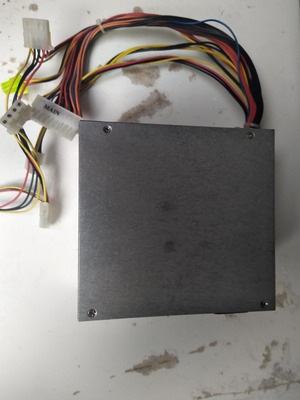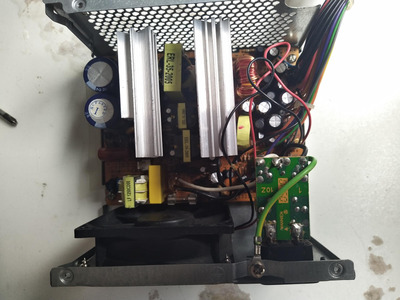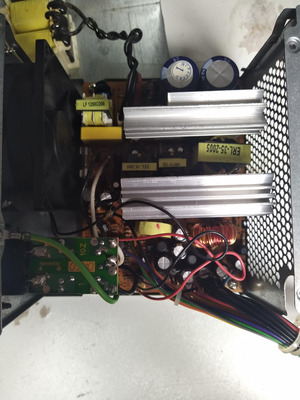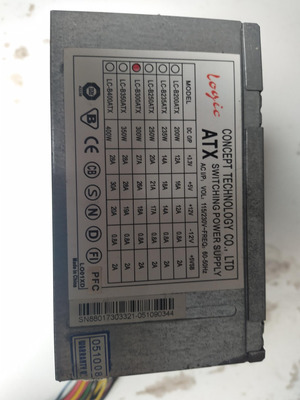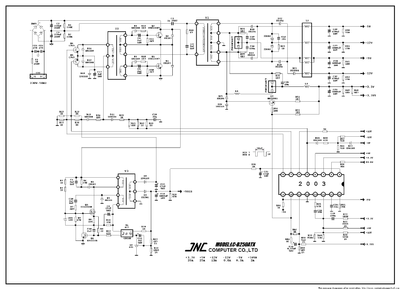That's a Deer / Solytech power supply. The "LC" series are pretty much the lowest end units... though yours actually looks much better built than the others. Anyways, I'll continue on this point later below.
Now for the high 5VSB...
WARNING: DO NOT CONNECT THIS POWER SUPPLY TO A MOTHERBOARD YET / WITHOUT CORRECTING THIS ISSUE.
Such high 5VSB = instant motherboard death, usually (typically the SIO / LPC bites the dust.)
What's the cause of the 5VSB going so high?
- Solytech used an old (almost ancient) design for the 5VSB circuit, known as 2-transistor self-oscillator. It has no PWM control ICs, and therefore such circuits usually have NO PROTECTION against... almost anything (including over-voltage.) That's not to say these circuits are bad. However, many of them often use a design with a "critical" startup cap, which when it fails, can make the 5VSB go very very high. The cap in question can be found close to the "EEL-19-2005" small transformer and primary heatsink. If I'm not mistaken, this cap is rated either 50V 22 uF or 50V 47 uF.
Not only that, but if the output caps on the 5VSB circuit (typically 2x 10V 1000 uF) fail, this can also cause the 5VSB to oscillate wildly and produce higher-than-normal voltages.
So the SOLUTION is: replace all of the above mentioned capacitors associated with the 5VSB circuit. For the 2x 1000 uF caps (or they might be 680 or 820 uF, depending oh how cheaply or not your PSU was built), you could also use 2x 1200 or 1500 or 2200 uF. It's the 5VSB circuit, so it doesn't care much. Just make sure to use good quality Japanese low-ESR caps.
By the way, this 5VSB design is what gave Bestec power supplies (and eMachines) a bad name. In the case of Bestec power supplies, actually only the ATX-250-12E model was responsible for this bad reputation. The ATX-250-12Z model uses a PWM-FET IC for the 5VSB and it's completely safe.
In regards to the rest of this LC-B300ATX power supply: it's not a completely gutless unit. Given the right parts, it should make for a decent 200-250 Watt power supply. The numbers on the label, of course, are a complete lie. I can't see the size of the rectifies attached on the secondary side heatsink, but from what I have seen in many of these units, typically the 5V will have a 20 or 25 or 30 Amp rectifier, 3.3V a 16 or 20 Amp rectifier, and 12V either a 10 or 12 or 16 Amp rectifier if you are very lucky. So depending on what your PSU has, that's what's going to be the max current for each rail.
Now, on the plus side, the input filtering is already there and Solytech did install proper Y2 and X2 safety EMI/RFI suppressing caps. The main transformer looks to be of proper 35 mm width, which is typically good for up to 300-350 Watt designs (at least for older half-bridge topologies like this.) And finally, it's good to see that each output rail (3.3V, 5V, and 12V) have 2 filter electrolytic caps and PI coils. The cheaper LC PSUs usually omit the PI coils and may have only 1 cap per output rail (or they will only have 2x 1000 uF caps instead of 2200 uF caps). That said, post a picture of the underside of the PSU. Some ultra-cheap LC designs bypassed the PI coils with traces. With the LC line, you never know what you are going to get until you open it and inspect it carefully. But again, once rebuilt, they do make for decent PSUs. I have a Deer DR-250ATX that's almost the same thing as the LC line. It's been powering a Pentium III PC for 15 years now. Of course I had it fully recapped it when I got it (it was a freebie unit and dead, due to... *sigh*... bad caps.) It was my 2nd or 3rd PSU recap back in the late 2000's and still works great to this day.
That said, try replacing the caps mentioned above and see if the 5VSB goes back to normal operation. Then see if the power supply will turn on when you jumper PS-ON to ground. If not, it's possible that either the PWM chip or the BJT driver circuit got damaged from the over-voltage, since these are also supplied by the 5VSB supply (actually, they are supplied by their own auxiliary power rail, but this rail is also derived from the 5VSB transformer, so that's why the damage can be a little more widespread.)
In any case, these PSUs are pretty easy to fix and don't require any special unobtanium parts. The "2005" PWM IC might be the hardest one to find (if it has been damaged). Otherwise, the rest is all "jellybean" parts that anyone sells.
dominusprog wrote on 2024-03-21, 08:15:
Have you changed the mosfets? If not, changing them would be a good start.
There's going to be exactly 1 MOSFET in this PSU, and it will be for the 5VSB, on the primary heatsink. The fact that the 5VSB is outputting power, though, means that this MOSFET is OK.
The other two parts on the primary heatsink are going to be 2x E13007 or equivalent NPN BJTs. It's an ancient half-bridge design that Solytech and many many PSUs used for a lot of years - some as late as the mid-late 2000's. Gutless no-name PSUs also still use this design, since it's well understood and relatively cheap to build and modify.
